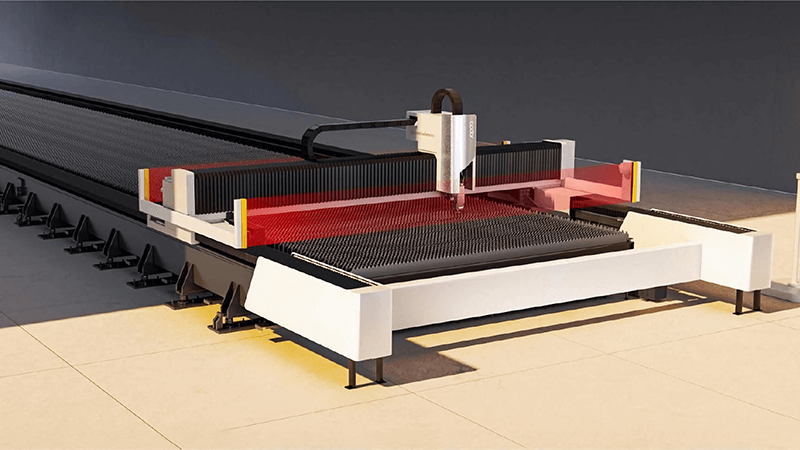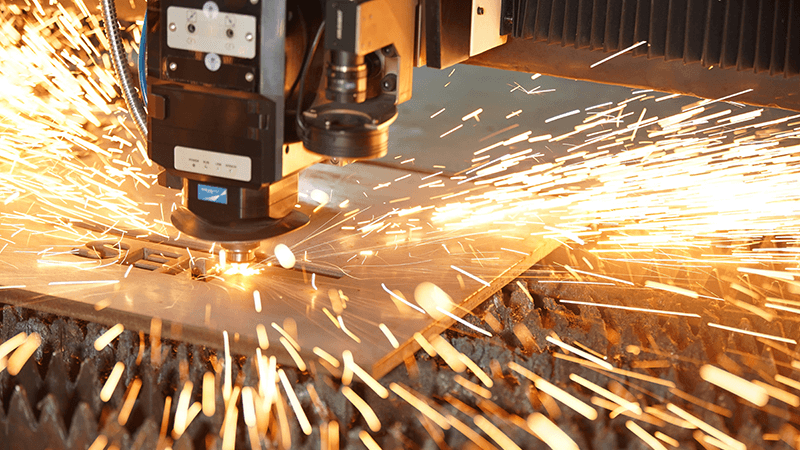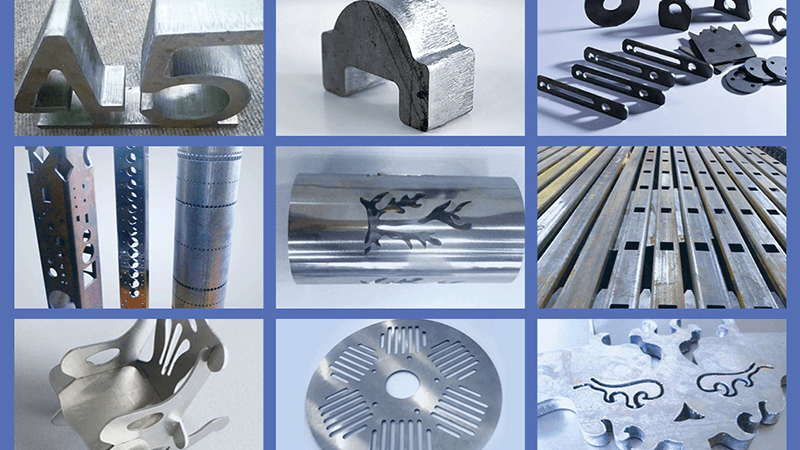When I first saw a fiber laser cutting machine, I was amazed by its speed and precision. Many people struggle to understand how this technology works and what makes it so effective.
A fiber laser cutting machine uses a concentrated beam of light to cut metal by melting or vaporizing it, then an assist gas blows away the molten material to create a clean and precise edge.
Fiber laser technology has changed modern manufacturing. If you are considering this type of machine, it helps to understand how it works, how it compares to CNC, and what its limits are.

How does a laser cutter work step by step?
When you watch a fiber laser cutting machine in action, it seems simple, but there is advanced technology behind every step.
The fiber laser cutting process starts with creating a laser beam inside a fiber doped with rare-earth elements, then focusing it through precision optics to melt or vaporize metal, while assist gas removes the molten material for a clean cut.
The core steps explained
-
Laser generation inside the fiber
The machine uses a special fiber doped with rare-earth ions, like ytterbium. A set of diode lasers pumps energy into the fiber, creating a very powerful and stable beam. -
Beam delivery
Unlike CO₂ lasers that use mirrors, fiber lasers1 transmit the beam directly through the optical fiber. This design reduces alignment problems and maintenance. -
Focusing the beam
Precision optics focus the beam to a very small point, concentrating all that energy. At this stage, the beam is powerful enough to melt or vaporize metal instantly. -
Cutting with assist gas
An assist gas2, like oxygen or nitrogen, blows away the molten metal or vapor. This step creates clean, narrow cuts with very small heat-affected zones.
| Step | Action | Result |
|---|---|---|
| 1 | Energy pumped into doped fiber | Creates laser beam |
| 2 | Beam sent through optical fiber | Stable delivery, low maintenance |
| 3 | Beam focused by precision optics | High-intensity cutting point |
| 4 | Assist gas clears molten metal | Clean and smooth edge |
The whole process is fast and efficient. At Kirin Laser, we design our fiber laser cutting machines to make these steps seamless, so users get consistent results with minimal downtime.

Is laser cutting better than CNC?
Many customers ask me if a fiber laser cutter is better than CNC machining. I always say it depends on your material and production needs.
Laser cutting is better for thin to medium sheet metal because it is faster, produces cleaner edges, and requires no direct tool contact, reducing wear and maintenance compared to CNC.
Comparing fiber laser and CNC machining
When you compare fiber laser cutting3 to CNC, think about speed, precision, and flexibility.
Speed
Fiber laser cutting is much faster when working with thin sheets of metal. The beam moves quickly and does not need to physically touch the material. CNC machines rely on mechanical tools, which move slower and wear down over time.
Precision
The focused laser beam produces extremely fine cuts with minimal heat distortion. CNC cutting can also be precise, but tool wear can affect accuracy over time.
Maintenance
Because the fiber laser uses light instead of physical contact, there are fewer parts that need regular replacement. CNC machines need frequent tool changes and alignments.
| Feature | Fiber Laser Cutting | CNC Machining |
|---|---|---|
| Speed | Very fast for thin sheet metal | Slower due to tool movement |
| Precision | Extremely high, minimal heat damage | High, but tool wear affects accuracy |
| Maintenance | Low, fewer moving parts | High, frequent tool changes |
| Edge Quality | Clean, no burrs | Burrs may need secondary finishing |
For many manufacturers, a fiber laser cutter4 is a better investment, especially for high-volume sheet metal production. At Kirin Laser, we focus on delivering machines that maximize these advantages.

What are the disadvantages of fiber laser cutting?
Fiber laser cutting is powerful, but no machine is perfect. There are limitations you should know before making a purchase.
The main disadvantages of fiber laser cutting are its high initial cost, limited cutting thickness compared to CO₂ or plasma, and sensitivity to reflective materials like copper or brass.
Understanding the limitations
When you plan to use a fiber laser cutter, it is important to balance its benefits with its challenges.
Initial cost
A fiber laser cutting machine5 has a high upfront price. However, many businesses find that the long-term savings from speed, precision, and low maintenance make it worthwhile.
Cutting thickness
While fiber lasers excel at cutting thin to medium metal sheets, they are not the best for very thick materials. Plasma cutting or waterjet cutting might be better for extremely thick metals.
Reflective materials
Materials like copper, brass, and some aluminum grades can reflect the laser beam. This reflection can damage the machine's internal components if not managed properly. At Kirin Laser, we include safety features to reduce this risk.
| Disadvantage | Explanation | Possible Solution |
|---|---|---|
| High initial cost | Expensive upfront investment | Calculate ROI over long term |
| Limited thickness | Not ideal for very thick metals | Use plasma or waterjet for thick cuts |
| Reflective materials | Can damage optics and source | Special coatings and safety systems |
Understanding these disadvantages helps you choose the right machine6 for your production goals.

What cannot be cut with a laser cutter?
Fiber laser cutters are versatile, but they cannot cut everything. Knowing the limits helps prevent damage and safety hazards.
Materials that cannot be cut include PVC, polycarbonate, highly reflective metals without safety systems, and certain dense composites due to toxic fumes or beam reflection.
Why some materials are off-limits
When we design fiber laser cutters at Kirin Laser, we consider both performance and safety.
Hazardous fumes
Some plastics, like PVC, release chlorine gas when cut. This gas is harmful to both humans and machines. Cutting these materials is dangerous without specialized ventilation and filtering systems.
Beam reflection
Highly reflective materials7, like copper or brass, can reflect the laser beam back into the optics. This reflection can damage the machine and cause safety issues.
Material density
Some composite materials are too dense or have mixed properties that make consistent cutting8 impossible. The result can be poor quality and wasted materials.
| Material Type | Problem | Recommendation |
|---|---|---|
| PVC Plastic | Releases toxic chlorine gas | Avoid cutting |
| Polycarbonate | Burns instead of cuts cleanly | Use mechanical cutting |
| Copper/Brass | High reflectivity damages optics | Use special laser with safety features |
| Dense composites | Inconsistent cutting results | Test samples first |
By knowing what not to cut, you protect your machine and your team. This knowledge also helps you plan production more effectively.

Conclusion
Fiber laser cutting machines9 have transformed modern manufacturing. They offer speed, precision, and reliability for cutting thin to medium sheet metals. While they have some limits, like initial cost and sensitivity to reflective materials, the benefits often outweigh the challenges. At Kirin Laser, we design machines that maximize these strengths and help our partners succeed in competitive markets.
-
Explore the benefits of fiber lasers for cutting, including efficiency and precision, to enhance your understanding of modern laser technology. ↩
-
Learn how assist gases like oxygen and nitrogen enhance laser cutting quality by creating cleaner cuts and reducing heat-affected zones. ↩
-
Explore this link to understand how fiber laser cutting can enhance efficiency and precision in manufacturing. ↩
-
Discover how a fiber laser cutter can enhance your manufacturing process with faster speeds, higher precision, and lower maintenance needs. ↩
-
Explore this link to understand the full potential and limitations of fiber laser cutting machines for informed decision-making. ↩
-
Discover expert tips and criteria to select the best fiber laser cutter tailored to your specific production requirements and goals. ↩
-
Learn about the dangers of cutting reflective materials like copper and brass, which can damage laser optics and pose safety risks. ↩
-
Understanding the challenges of consistent cutting helps optimize production and reduce waste, ensuring high-quality results and efficient operations. ↩
-
Finding the best laser cutting machine and laser cutting solutions from Kirin Laser, clicking this link to get all your needs for your business. ↩





